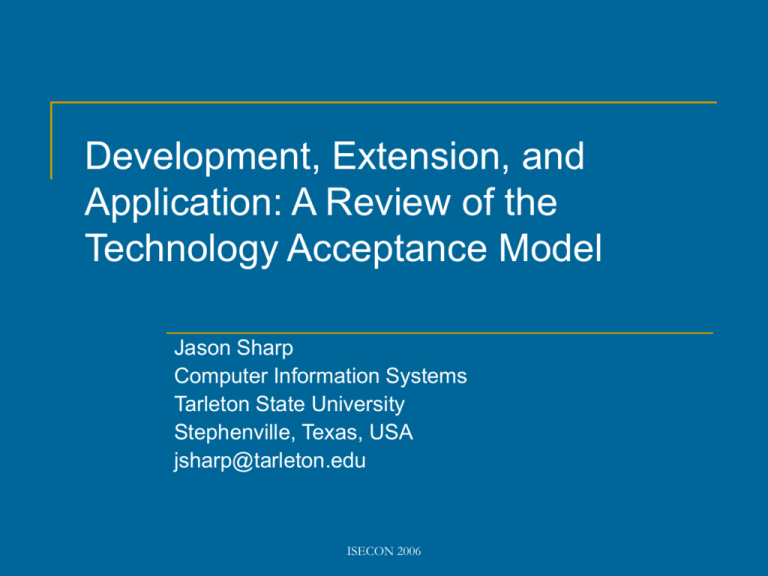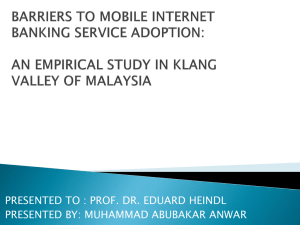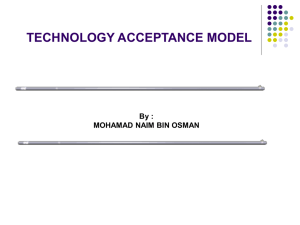Development, Extension, and Application
advertisement

Development, Extension, and Application: A Review of the Technology Acceptance Model Jason Sharp Computer Information Systems Tarleton State University Stephenville, Texas, USA jsharp@tarleton.edu ISECON 2006 Introduction Question: Why do people accept or reject technology? Technology Acceptance Model (TAM) Geared specifically toward information technology Strong reliability and validity of instruments Extensive research: 147 articles between 1990 and 2003 Good example of how a model is extended and applied Purpose: To examine the development, extension, and application of TAM in order to identify potential areas of research for future study To provide IS educators with a foundation for guiding students in regard to the TAM literature To provide a starting point for evaluating educational technologies To serve as a general reference for those interested in technology acceptance ISECON 2006 Methodology Keyword search of ABI Inform, Academic Search Premier, and IEEE Express Criteria: Extension of Legris, Ingham, and Collerette (2003) Compared articles utilizing a quantitative research method PLS, LISREL, path or regression analysis Broader range of journals than Legris et al. (2003) Prior analysis of articles from 1980 to 2001 Current analysis of articles from 2001 to 2005 Prior analysis included only six IT related journals Articles grouped on logical categories chosen by the author (Strauss & Corbin, 1998) ISECON 2006 A Review of the Technology Acceptance Model Development ISECON 2006 Development: TAM (Original) Perceived Usefulness Attitude Perceived Ease of Use Davis (1989) Intention to Use Usage Behavior Perceived ease of use – “the degree to which a person believes that using a particular system would be free of effort” (Davis, 1989, p. 320) Perceived usefulness – “the degree to which a person believes that using a particular system would enhance his or her job performance” (p. 320) ISECON 2006 Development: TAM (Original) Study 1 Study 2 Technology: PROFS electronic mail and XEDIT editor Sample Size: 120 users employed by IBM Technology: Chart-Master and Pendraw Sample Size: 40 MBA students Overall Findings: Perceived Usefulness significant determinant of Usage Perceived Ease of Use significant determinant of Usage Effect of Perceived Usefulness significantly greater than Perceived Ease of Use Attitude does not fully mediate effect of Perceived Usefulness and Perceived Ease of Use on Behavior Perceived Ease of Use as an antecedent of Perceived Usefulness ISECON 2006 Development: TAM (Parsimonious) Study (Davis, Bagozzi, and Warshaw, 1989) Technology: WriteOne, word processor Sample Size: 107 MBA students Overall Findings Perceived Usefulness strong significant determinant of Usage Perceived Ease of Use significant determinant of Usage, but significantly weaker than Perceived Usefulness Attitude only partially mediated effects of Perceived Usefulness and Perceived Ease of Use on Usage ISECON 2006 Development: TAM (Parsimonious) Perceived Usefulness Intention to Use Usage Behavior Perceived Ease of Use Davis, Bagozzi, and Warshaw (1989) ISECON 2006 Development: TAM2 Experience Voluntariness Subjective Norm Image Perceived Usefulness Job Relevance Output Quality Result Demonstrability Intention to Use Perceived Ease of Use Venkatesh and Davis (2000) ISECON 2006 Usage Behavior Development: TAM2 Subjective Norm – influence of others on user’s decision to use or not use Image – maintaining a favorable standing Job Relevance – degree to which the target system is applicable Output Quality – how well the system performs tasks Result Demonstrability – tangible results Experience – with the system Voluntariness – perception of voluntary/mandatory use ISECON 2006 Development: TAM2 Study 1 (voluntary): Study 2 (voluntary): Technology: Migration to Windows-based environment Sample Size: 39 personal financial services employees Study 3 (mandatory): Technology: Proprietary system Sample Size: 38 floor supervisors Technology: Windows-based account management system Sample Size: 43 accounting firm services employees Study 4 (mandatory): Technology: Stock portfolio analysis system Sample Size: 36 investment banking employees ISECON 2006 Development: TAM2 Experience Voluntariness Subjective Norm Image Perceived Usefulness Job Relevance Output Quality Result Demonstrability Intention to Use Perceived Ease of Use Venkatesh and Davis (2000) ISECON 2006 Usage Behavior Development: Antecedents of Perceived Ease of Use Perceived Usefulness Computer Self-Efficacy Intention to Use Objective Usability Usage Behavior Perceived Ease of Use Computer Self-efficacy – how does the user feel about their ability to use technology Direct Experience Objective Usability – objective system measures, e.g., keystroke model, expert to novice performance comparison Venkatesh and Davis (1996) ISECON 2006 Development: Antecedents of Perceived Ease of Use Study 1: Study 2: Technology: WordPerfect and Lotus Sample Size: 36 undergraduate students Study 3: Technology: Chartmaster and Pendraw Sample Size: 40 MBA students Pine (electronic mail) and Gopher (information access) Sample Size: 32 part-time MBA students Overall Findings Before hands-on experience, Computer Self-efficacy was a significant determinant of Perceive Ease of Use, Objective Usability was not After direct experience, both Computer self-efficacy and Objective Usability were significant determinants of Perceived Ease of Use ISECON 2006 Development: Antecedents Revised Computer Self-Efficacy Perception of External Control Computer Anxiety Computer Playfulness Perception of External Control - availability of support staff Computer Anxiety – apprehension or fear Computer Playfulness – desire to explore and play Perceived Enjoyment – enjoyable apart from performance consequences Perceived Usefulness Intention to Use Perceived Ease of Use Perceived Enjoyment Objective Usability Venkatesh (2000) ISECON 2006 Usage Behavior Development: Antecedents of Perceived Ease of Use Three studies measured three times over three months Study 1: Study 2: Technology: Multimedia system for property management Sample Size: 145 real estate agency employees Study 3: Technology: Interactive online help desk system Sample Size: 58 retail electronic store employees Technology: Migration to PC-based environment Sample Size: 43 financial services employees Pooled Results T1: Perceived Enjoyment and Objective Usability not significant T2: All antecedents significant T3: Computer Playfulness not significant ISECON 2006 A review of the Technology Acceptance Model Extension ISECON 2006 Extension: Determinants of Intention to Use Author Determinant Finding Hu et al. (2005) Availability Not significant Huang (2005); Moon & Kim (2001) Perceived Playfulness Not significant Significant Gong et al. (2004) Computer Self-efficacy Significant Mathieson et al. (2004) Perceived Resources Significant Chau & Hu (2002) Perceived Behavioral Control Significant Yi & Hwang (2003) Application Specific Self-efficacy Significant Van der Heijden (2004) Perceived Enjoyment Significant ISECON 2006 Extension: Determinants of Attitude Author Determinant Finding Huang (2005); Moon & Kim (2001) Perceived Playfulness Significant Shih (2004) Relevance Significant ISECON 2006 Extension: External Variables of Usefulness Author External Variable Finding Hu et al. (2005) Efficiency Gain Significant Chan & Lu (2004) Perceived Risk Significant Amoako-Gyampah et al. (2004) Shared Beliefs Significant Chau (2001) Computer Attitude Significant Hong et al. (20012002); Shih (2004) Relevance Significant Liaw & Huang (2003); Yi & Hwang (2003) Perceived Enjoyment Significant ISECON 2006 Extension: External Variables of Ease of Use Author External Variable Finding Amoako-Gyampah et al. (2004) Shared Beliefs, Training Significant Chau (2001) Computer Attitude Not significant Mathieson et al. (2001) Perceived Resources Not significant Hong et al. (20012002) Knowledge of Search Domain Significant Hong et al. (20012002); Shih (2004) Relevance Significant Liaw & Huang (2003) Individual Computer Experience Significant ISECON 2006 A review of the Technology Acceptance Model Application ISECON 2006 Application: Original TAM (Supporting) Author Technology Sample Size Hu et al. (2005) COPLINK 283 police officers Huang (2005) Women-centric Web site 390 subjects Amoako-Gyampah & Salam (2004) ERP system 409 end-users Mathieson et al. (2001) Bulletin board system 401 members of IMA Chau & Hu (2002) Telemedicine 408 physicians Perceived Usefulness a stronger determinant than Perceived Ease of Use ISECON 2006 Application: Original TAM (Opposing) Author Gong et al. (2004) Technology Web-based learning system Sample Size 152 teachers Moon & Kim (2001) World Wide Web 152 graduate students Shih (2004) Internet utilization behavior 203 office workers Brown et al. (2002) Computer banking 107 bank employees system Perceived Ease of Use a stronger determinant than Perceived Usefulness ISECON 2006 Application: Influence of Attitude on Intention Author Finding Hu et al. (2005) Not significant Huang (2005) Significant Amoako-Gyampah & Salam (2004) Significant Mathieson et al. (2001) Significant Chau & Hu (2002) Significant Gong et al. (2004) Significant Moon & Kim (2001) Significant Shih (2004) Significant Brown et al. (2002) Not significant ISECON 2006 Application: Parsimonious TAM (Supporting) Author Technology Sample Hong et al. (20012002) Digital library 585 students Chau (2001) General IT usage 360 undergraduate business students Liaw & Huang (2003) Search engines 114 medical students Lin & Wu (2004) End-user computing 195 workers Yi & Hwang (2004) Web-based information system 109 introductory IS students Perceived Usefulness a stronger determinant than Perceived Ease of Use ISECON 2006 Application: Parsimonious TAM (Opposing) Author Van der Heijden (2004) Technology Sample Hedonic 1114 users of a Dutch information system movie Web site Perceived Ease of Use a stronger determinant than Perceived Usefulness ISECON 2006 Application: TAM2 (Mixed results) Author Chan & Lu (2004) Technology Internet banking Sample 499 undergraduate and graduate students • Subjective Norm and Image significant determinant of Perceived Usefulness • Results Demonstrability not a significant determinant of Perceived Usefulness • Perceived Ease of Use significant determinant of Perceived Usefulness, but not of Intention to Use • Perceived Usefulness significant determinant of Intention to Use ISECON 2006 Application: Environment Volitional Mandatory Hu et al. (2005) Davis & Venkatesh (2000) Huang (2005) Brown et al. (2002) Amoako-Gyampah & Salam (2004) Mathieson et al. (2001) Chau & Hu (2002) Gong et al. (2004) Moon & Kim (2001) Shih (2004) Hong et al. (2001-2002) Chau (2001) Liaw & Huang (2003) Lin & Wu (2004) Yi & Hwang (2004) Van der Heijden (2004) Chan & Lu (2004) ISECON 2006 Research Potential Mixed results of Perceived Usefulness and Perceived Ease of Use as the stronger determinant Volitional versus mandatory use environments Ten studies supported Perceived Usefulness Six studies supported Perceived Ease of Use How does the type of technology of affect the results? Fifteen studies conducted in volitional environments Two studies conducted in mandatory environments How does the environment affect the results? The role of Attitude Seven studies indicated Attitude as a direct determinant Two studies indicated Attitude is not a direct determinant Does attitude play a greater role than previously thought? ISECON 2006 Importance to Information Systems Educators Provides a foundation for assisting faculty to guide students about the history of TAM Provides a quick summary of statistical significance of various determinants and external variables Provides a starting point for evaluating educational technologies Provides a ready reference of current technologies evaluated with TAM ISECON 2006 Conclusion Examined the development, extension, and application of TAM Identified three specific areas for future research Constructed a ready reference for IS educators Developed a general overview of TAM for those interested in technology acceptance ISECON 2006 Development, Extension, and Application: A Review of the Technology Acceptance Model Jason Sharp Computer Information Systems Tarleton State University Stephenville, Texas, USA jsharp@tarleton.edu ISECON 2006 References Amoako-Gyampah, K., & Salam, A. F. (2004). An extension of the technology acceptance model in an ERP implementation environment. Information & Management, 41(6), 731-745. Chan, S., & Lu, M. (2004). Understanding internet banking adoption and use behavior: A Hong Kong perspective. Journal of Global Information Management, 12(3), 21-43. Chau, P. Y. K. (2001). Influence of computer attitude and self-efficacy on IT usage behavior. Journal of End User Computing, 13(1), 26-33. Chau, P. Y. K., & Hu, P. (2002). Investigating healthcare professionals’ decisions to accept telemedicine technology: An empirical test of competing theories. Information & Management, 39(4), 297-311. Brown, S. A., Massey, A. P., Montoya-Weiss, M. M., & Burkman, J. R. (2002). Do I really have to? User acceptance of mandated technology. European Journal of Information Systems, 11(4), 283-295. Davis, F. D. (1989). Perceived usefulness, perceived ease of use, and user acceptance of information technology. MIS Quarterly, 13(3), 319-339. Davis, F. D., Bagozzi, R. P., & Warshaw, P. R. (1989). User acceptance of computer technology: A comparison of two theoretical models. Management Science, 35(8), 982-1003. Delone, W. H., & McLean, E. R. (1992). Information systems successes: The quest for the dependent variable. Information Systems Research, 3(1), 60-95. Delone, W. H., & McLean, E. R. (2003). The Delone and McLean model of information systems Success: A ten-year update. Journal of Management Information Systems, 19(4), 9-30. Fishbein, M., & Ajzen, I. (1975). Belief, attitude, intention and behavior: An introduction to theory and research. Reading, MA: Addison-Wesley. Gong, M., Xu, Y., Yu, Y. (2004). An enhanced technology acceptance model for web-based Learning. Journal of Information Systems Education, 15(4), 365-374. Hong, W., Thong, J. Y. L., Wong, W., & Tam, K. (2001-2002). Determinants of user acceptance of digital libraries: An empirical examination of individual differences and system characteristics. Journal of Management Information Systems, 18(3), 97-124. ISECON 2006 References Horton, R. P., Buck, T., Waterson, P. E., & Clegg, C. W. (2001). Explaining intranet use with the technology acceptance model. Journal of Information Technology, 16(4), 237-249. Hu, P. J., Lin, C., & Chen, H. (2005). User acceptance of intelligence and security informatics technology: A study of COPLINK. Journal of the American Society for Information Science and Technology, 56(3), 235-244. Huang, E. (2005). The acceptance of women-centric websites. The Journal of Computer Information Systems, 45(4), 75-83. Liaw, S. S., & Huang, H. M. (2003). An investigation of user attitudes toward search engines as an information retrieval tool. Computers in Human Behavior, 19(6), 751-765. Lin, F., & Wu, J. (2004). An empirical study of end-user computing acceptance factors in small and medium enterprises in Taiwan: Analyzed by structural equation modeling. Journal of Computer Information Systems, 44(3), 98-108. Mathieson, K., Peacock, E., & Chinn, W. C. (2001). Extending the technology acceptance model: The influence of perceived user resources. The Data Base for Advances in Information Systems, 32(3), 86-112. Moon, J. W., & Kim, Y. G. (2001). Extending the TAM for a world-wide-web context. Information & Management, 38(4) 217-230. Shih, H. (2004). Extended technology acceptance model of internet utilization behavior. Information & Management, 41(6), 719-729. Van der Heijden, H. (2004). User acceptance of hedonic information systems. MIS Quarterly, 28(4), 695-704. Venkatesh, V. (2000). Determinants of perceived ease of use: Integrating control, intrinsic motivation, and emotion into the technology acceptance model. Information Systems Research, 11(4), 342-365. Venkatesh, V., & Davis, F. D. (1996). A model of antecedents of perceived ease of use: Development and test. Decision Sciences, 27(3), 451-481. Venkatesh, V., & Davis, F. D. (2000). A theoretical extension of the technology acceptance model: Four longitudinal field studies. Management Science, 46(2), 186-204. Wixom, B. H., & Todd, P. A. (2005). A theoretical integration of user satisfaction and technology acceptance. Information Systems Research, 16(1), 85-102. Yi, M. Y., & Hwang, Y. (2004). Predicting the use of web-based information systems: Self-efficacy, enjoyment, learning goal orientation, and the technology acceptance model. International Journal of Human-Computer Studies, 59(4), 431-449. ISECON 2006





